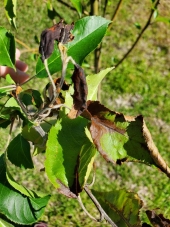Looks like you have more of an insect issue than a microbial one (for now).
Those tubes appear to be formed by the granulate ambrosia beetle, a borer that excretes its waste to form them (frass strands).
The females choose which trees to attack based on how much stress they're in (as detected by their ethanol production). The most common stressors are flooding (soil saturation 30%+ moisture), or frost damage.
You can create traps baited with ethanol to get the beetles... because they share a fascination with the chemical.
The link at bottom offers this as a treatment guideline:
"Heavily infested plants or plant parts should be removed and destroyed. It may be best for large growers to wait 3-4 weeks after trees are attacked before removal so as to concentrate and destroy the greatest number of beetles, possibly sparing some healthy trees."
I must admit, this was a good challenge as far as research binges go; at first I thought for sure it was strictly fungal... thanks for the opportunity to do some more learning!
https://content.ces.ncsu.edu/granulate-asian-ambrosia-beetle-1




